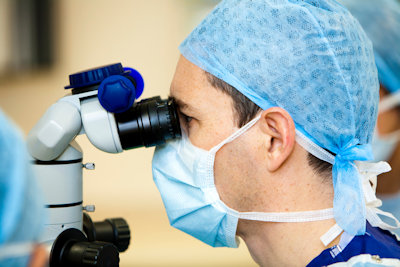If you are over age 60, you may have quite a few friends who are having cataract surgery. In fact, many of your friends in Fort Myers may be talking about the new laser-assisted cataract surgery procedure they’ve had at Elmquist Eye Group. After age 60, one in three people will eventually need to have cataract surgery. It is very important to consider your options, and our surgeons can help you with that.
Laser Cataract Surgery vs. Traditional Surgery
 Laser-assisted cataract surgery is a newer form of cataract surgery. The technique uses a specialized ultrasound camera to more precisely create a customized computerized map of the eye lens surface. Using this map, the surgeon creates a surgical plan to guide both the depth and size of the incisions needed to repair the cataract. During the surgery, a femtosecond laser is used to make the incisions in the lens. The surgeon then uses ultrasound to break up the protein deposits that form the cloudy cataract. The laser procedure has been used worldwide and is very safe and effective.
Laser-assisted cataract surgery is a newer form of cataract surgery. The technique uses a specialized ultrasound camera to more precisely create a customized computerized map of the eye lens surface. Using this map, the surgeon creates a surgical plan to guide both the depth and size of the incisions needed to repair the cataract. During the surgery, a femtosecond laser is used to make the incisions in the lens. The surgeon then uses ultrasound to break up the protein deposits that form the cloudy cataract. The laser procedure has been used worldwide and is very safe and effective.
Traditional cataract surgery is one of the most frequently performed surgeries around the world. In the United States alone, surgeons perform over 1.5 million surgeries every year, therefore this surgical method is a proven procedure that is both safe and effective. This surgery is known by the term phacoemulsification. During this surgery, the surgeon uses a traditional metal scalpel blade to create a small incision in the cornea. Ultrasound is then used to break up the cloudy cataract that is covering and obstructing the lens. A new artificial lens called an intraocular lens or IOL is implanted to replace your natural lens.
Should I Have Laser Cataract Surgery?
The surgeon will recommend traditional or laser-assisted surgery largely based on the type of cataract present in the patient. These days, it is not only possible to remove the cataract, but it is also possible to implant an IOL to correct a refractive error in your vision. Neither the traditional nor the laser-assisted procedure requires stitches, and the recovery periods for both surgeries are about the same.
Surgeons generally regard the laser surgery as more precise, and it takes less time to perform than the traditional surgery. Surgeons achieve more accuracy with the laser procedure, and get better results for certain types of vision correction like astigmatism and other refractive error corrections.
The laser is used to pre-treat the eye by softening the cataract before the ultrasound breaks it up. Because the lens is softened, there is less chance of eye damage during the procedure. The laser breaks up the pieces of the cataract so well that many surgeons find they do not even need ultrasound.
As with any surgery, results do vary among individuals; some people see clearly right away, while others take about a week or two to achieve clear vision in about a week or two. Talk to one of our expert and experienced Elmquist Eye Group surgeons to determine your best cataract option. Give us a call today to start down the path to the best laser-assisted cataract surgery in Fort Myers. You’ll be glad you did!
